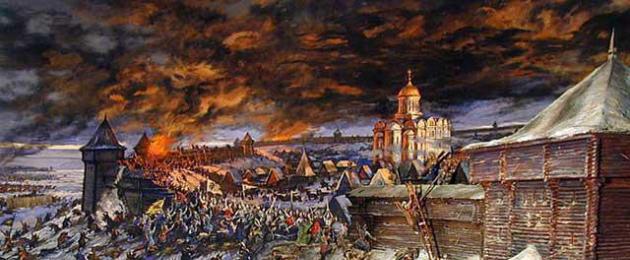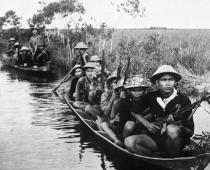The Mongol-Tatar invasion caused enormous damage to the political, economic and cultural development of Russia. The invasion of the Central Asian nomads caused a wave of resistance from our people. However, the population of some fortified points, which preferred to surrender to the victor without a fight, sometimes bitterly regretted this. Let's find out which cities of Russia resisted the Mongol troops?
Background of the Mongol invasion of Russia
The great Mongol commander Genghis Khan created a huge empire, in territory exceeding the size of all hitherto existing states. Even during his lifetime, nomadic hordes invaded the expanses of the Sea of \u200b\u200bAzov, where in the battle on the Kalka River they utterly defeated the Russian-Polovtsian army. It is believed that this was reconnaissance in force, designed to further pave the way for the Mongol-Tatars to Eastern Europe.
The mission of conquering the peoples of Europe was entrusted to the descendants of Jochi, who were allocated the western ulus of the empire as a lot. The decision to march west was made at the All-Mongolian Kurultai in 1235. The son of Jochi Batu Khan (Batu) became the head of the huge one.
The first to fall under the onslaught of his troops was the Bulgar Khanate. Then he moved his hordes to. During this invasion, Batu captured the large cities of Russia, which will be discussed in detail below. The inhabitants of the countryside were not much more fortunate, because the crops were trampled down, and many of them were either killed or taken prisoner.
So, let's see which cities of Russia resisted the Mongol troops.
Defense of Ryazan
The first of the Russian cities to experience the power of the Mongol strike was the city led by Prince Yuri Igorevich of Ryazan, who was assisted by his nephew Oleg Ingvarevich Krasny.

After the beginning of the siege, the Ryazanians showed miracles of heroism and steadfastly held the city. They successfully repulsed the attacks of the Mongols for five days. But then the Tatars brought their siege weapons, which they learned to use while fighting back in China. With the help of these technical structures, they managed to destroy the walls of Ryazan and take the city in three days. It happened in December 1237.
Prince Igor Yurievich was killed, Oleg Ingvarevich was taken prisoner, partially killed, partially escaped in the forests, and the city itself was completely destroyed and never rebuilt in that place.
Capture of Vladimir
After the capture of Ryazan, other cities began to fall under the pressure of the Mongols. The states in Russia in the form of principalities, due to their disunity, could not give a worthy rebuff to the enemy. The Mongols captured Kolomna and Moscow. Finally, the Tatar army approached the city of Vladimir, which had been abandoned before. The townspeople began to prepare for a heavy siege. The city of Vladimir in Ancient Russia was a major economic and political center, and the Mongols understood its strategic importance.

The leadership of the defense of the city in the absence of his father was taken over by the sons of the Grand Duke of Vladimir Mstislav and Vsevolod Yuryevich, as well as the voivode Pyotr Oslyadyukovich. Nevertheless, Vladimir was able to hold out for only four days. In February 1238 he fell. The last defenders of the city took refuge in the caves of the Assumption Cathedral, but this brought them only a small respite from death. A month later, on the City River, the final defeat was inflicted on the prince of Vladimir Russia, Yuri Vsevolodovich. In this battle he died.
Kozelsk - "evil city"
When the question is raised about which cities of Russia resisted the Mongol troops, Kozelsk is definitely remembered. His heroic resistance deservedly entered the textbooks on the history of our Motherland.
Until the beginning of April 1238, the Mongols approached the small town of Kozelsk, which was the capital of a specific principality located in the Chernigov land. The prince there was twelve-year-old Vasily from the Olgovich family. But, despite its size and the infancy of the ruler, Kozelsk put up the longest and most desperate resistance to the Mongols from all the Russian fortresses taken before. With relative ease, Batu captured the large cities of Russia, and this small settlement was taken only by placing more than four thousand selected Mongol soldiers near its walls. The siege lasted seven weeks.

Because of the high price that Batu had to pay for the capture of Kozelsk, he ordered from now on to call it the "evil city." The entire population was brutally destroyed. But on the other hand, the weakened Mongol army was forced to return to the steppe, thereby postponing the death of the capital city of Russia - Kyiv.
The death of Kyiv
Nevertheless, already in the next 1239, the Mongols continued their western campaign, and, returning from the steppes, they captured and destroyed Chernigov, and in the fall of 1240 they approached Kiev, the mother of Russian cities.

By that time, it was only formally the capital of Russia, although it remained the largest city. Prince Daniel of Galicia-Volyn controlled Kyiv. He put his thousandth Dmitri in charge of the city, who led the defense against the Mongols.
Almost the entire Mongol army, participating in the western campaign, approached the walls of Kyiv. According to some sources, the city managed to hold out for three whole months, according to others, it fell in just nine days.
After the capture of Kyiv, the Mongols invaded Galician Rus, where they were especially stubbornly resisted by Danilov, Kremenets and Kholm. After the capture of these cities, the conquest of the Russian lands by the Mongols could be considered over.
The consequences of the capture of Russian cities by the Mongols
So, we found out which cities of Russia resisted the Mongol troops. They suffered the most from the Mongol invasion. At best, their population was sold into slavery, and at worst, it was completely slaughtered. The cities themselves were burned and leveled to the ground. True, most of them still managed to rebuild later. However, humility and fulfillment of all the requirements of the Mongols, as history shows, did not guarantee the city that it would remain intact.
Nevertheless, after several centuries, the Russian principalities strengthened, relying, among other things, on cities, and were able to throw off the hated Mongol-Tatar yoke. The period of Muscovite Russia began.
- In contact with 0
- Google+ 0
- OK 0
- Facebook 0








